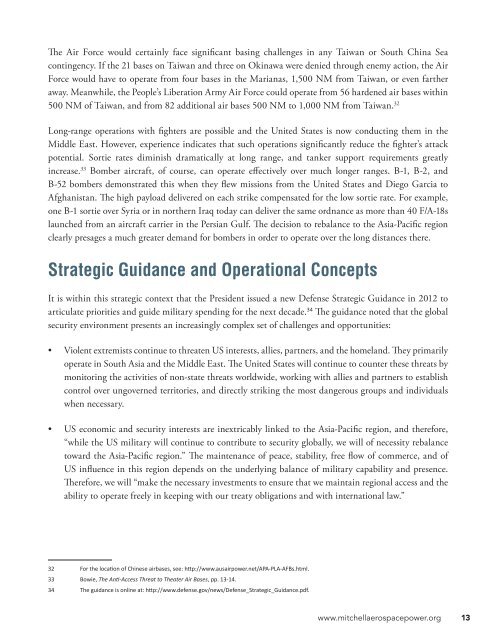You also want an ePaper? Increase the reach of your titles
YUMPU automatically turns print PDFs into web optimized ePapers that Google loves.
The Air Force would certainly face significant basing challenges in any Taiwan or South China Sea<br />
contingency. If the 21 bases on Taiwan and three on Okinawa were denied through enemy action, the Air<br />
Force would have to operate from four bases in the Marianas, 1,500 NM from Taiwan, or even farther<br />
away. Meanwhile, the People’s Liberation Army Air Force could operate from 56 hardened air bases within<br />
500 NM of Taiwan, and from 82 additional air bases 500 NM to 1,000 NM from Taiwan. 32<br />
Long-range operations with fighters are possible and the United States is now conducting them in the<br />
Middle East. However, experience indicates that such operations significantly reduce the fighter’s attack<br />
potential. Sortie rates diminish dramatically at long range, and tanker support requirements greatly<br />
increase. 33 Bomber aircraft, of course, can operate effectively over much longer ranges. B-1, B-2, and<br />
B-52 bombers demonstrated this when they flew missions from the United States and Diego Garcia to<br />
Afghanistan. The high payload delivered on each strike compensated for the low sortie rate. For example,<br />
one B-1 sortie over Syria or in northern Iraq today can deliver the same ordnance as more than 40 F/A-18s<br />
launched from an aircraft carrier in the Persian Gulf. The decision to rebalance to the Asia-Pacific region<br />
clearly presages a much greater demand for bombers in order to operate over the long distances there.<br />
Strategic Guidance and Operational Concepts<br />
It is within this strategic context that the President issued a new Defense Strategic Guidance in 2012 to<br />
articulate priorities and guide military spending for the next decade. 34 The guidance noted that the global<br />
security environment presents an increasingly complex set of challenges and opportunities:<br />
• Violent extremists continue to threaten US interests, allies, partners, and the homeland. They primarily<br />
operate in South Asia and the Middle East. The United States will continue to counter these threats by<br />
monitoring the activities of non-state threats worldwide, working with allies and partners to establish<br />
control over ungoverned territories, and directly striking the most dangerous groups and individuals<br />
when necessary.<br />
• US economic and security interests are inextricably linked to the Asia-Pacific region, and therefore,<br />
“while the US military will continue to contribute to security globally, we will of necessity rebalance<br />
toward the Asia-Pacific region.” The maintenance of peace, stability, free flow of commerce, and of<br />
US influence in this region depends on the underlying balance of military capability and presence.<br />
Therefore, we will “make the necessary investments to ensure that we maintain regional access and the<br />
ability to operate freely in keeping with our treaty obligations and with international law.”<br />
32 For the location of Chinese airbases, see: http://www.ausairpower.net/APA-PLA-AFBs.html.<br />
33 Bowie, The Anti-Access Threat to Theater Air Bases, pp. 13-14.<br />
34 The guidance is online at: http://www.defense.gov/news/Defense_Strategic_Guidance.pdf.<br />
www.mitchellaerospacepower.org 13


